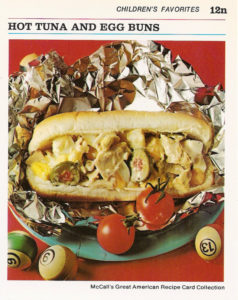Culinary Creations of the American Past
When it comes to home cooking, the American public has taken giant strides in the last half century. Home cooks today not only have affordable access to commercially designed tools (immersion circulators, stainless steel cookware, food processors), but the overwhelming amount of information and more convenient availability of fresher, more local ingredients has changed the way home cooks view their abilities and the food itself.
Today, we have Bon Appétit, Saveur, Art Culinaire, Food and Wine, and an array of other publications, available in a slew of platforms. Side note: the aforementioned publications are just a few of our favorite subscriptions, and if you are like me, the simple pleasure of anticipation and wonder while unwrapping the cellophane from a freshly delivered copy, is so worth paying for the printed copies. But, we are no longer confined to just magazines and cookbooks; culinary resources exist in so many ways. Entire television networks are devoted to home cooking; home cooks share trials, successes, and failures through instant communication; and, free-of-charge online videos are now at your fingertips. We have likely never lived in a more culinary time in history. It is an incredible time to cook for yourself. But, it has been an awkward road we have traveled.
The McCall Corporation, founded in 1913 by Scottish tailor James McCall, was a popular American publishing company printing magazines for an array of popular interests. Among their publications in the 1960s and 1970s were the Saturday Review, Popular Mechanics, Redbook, and McCall’s – latter two belonging to a group of magazines, known as the Seven Sisters, traditionally aimed at married, homemaker women with husbands and children. As part of the McCall’s subscription, households received collections of recipe cards providing homemakers with step-by-step instructions for an arsenal of dishes. Collectively, the cards were titled McCall’s Great American Recipe Card Collection.
Hundreds of recipes were published and likely millions were printed, mailed, and stored in special plastic boxes provided when the subscription was purchased. In all practicality, it was probably a very successful and helpful campaign that transcended generations, as cards were passed from parents to newlyweds. Unfortunately, by today’s standards, the choice of ingredients and quality of photography has a less than mouth-watering effect. We have chosen five of the most comical, awkward, and sometimes revolting cards. While we sincerely hope these cards were never drawn from the security of the plastic box, we know some poor family, somewhere, was subjected to the most monstrous creations of the McCall Corporation.
EGGS EN GELEE
We are going to start where every good meal should start – the amuse bouche. Someone, in some New York City office, kicked back, feet up, said, “You know, French food is fancy. What’s the French equivalent of a deviled egg?” Eggs En Gelee, yup, you read that right, gelatin encased soft boiled eggs. And, to spice it up a bit, and make it a little more ‘Frenchy,’ add blanched tarragon leaves and liver paté. 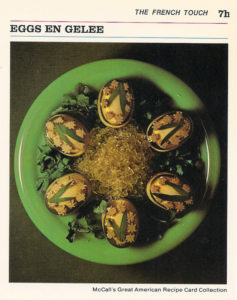 What, does that not pique your appetite? Well maybe you just need to see it, finished and displayed. The garnish really brings life to the dish. A bed of parsley (not that fancy Italian stuff, this is a French dish) and a mound of finely chopped leftover gelatin really brings the plate together.
What, does that not pique your appetite? Well maybe you just need to see it, finished and displayed. The garnish really brings life to the dish. A bed of parsley (not that fancy Italian stuff, this is a French dish) and a mound of finely chopped leftover gelatin really brings the plate together.
Ingredients:
6 eggs
2 envelopes unflavored gelatin
2 cans (12 1/2 oz size) chicken consommé
1/2 cup white wine
1 tablespoon tarragon
vinegar
3/4 teaspoon salt
Boiling water, ice water
12 fresh tarragon leaves, or parsley sprigs
4 tablespoons liver pate
1 teaspoon heavy cream
Directions:
- Gently lower eggs into boiling water in medium saucepan. Remove pan from heat. Cover; let stand 3 to 5 minutes. Cool eggs under cold water to prevent further cooking.
- In small saucepan, sprinkle gelatin over 1 cup consommé to soften. Stir over low heat, to dissolve gelatin. Stir in rest of consommé, white wine, vinegar, and salt; set aside.
- Pour boiling water over tarragon leaves. Drain, then plunge leaves into ice water. Beat pate with heavy cream until smooth. Place in pastry bag with small star tip.
- Place 6 (6-oz) oval molds or custard cups in pan of ice and water. Spoon 1 tablespoon gelatin mixture into each mold. Let stand about 5 minutes, or just until gelatin is set. Arrange 2 drained tarragon leaves on gelatin in each mold. Pipe liver paté in little stars or in ring around leaves. Cover with another tablespoon of gelatin mixture, being careful to keep decoration intact. Let stand until gelatin is firm.
- Meanwhile, carefully peel eggs. Place an egg in center of each mold on firm gelatin layer. Pour enough gelatin mixture around eggs just to cover. Refrigerate until firm.
- To unmold: Dip molds in hot water; invert onto individual serving plates; shake gently to release. Garnish with parsley, if desired, and remaining gelatin, chopped, as show in photography. Makes 6 servings
PERFECTION SALAD
An increase in local farming and communities advocating farmers’ markets, the availability and enjoyment of fresh fruits and vegetables is on the rise. Salads are one of the best ways to enjoy fresh flavors and provide the body with much needed fiber and antioxidants. Obviously, something called ‘Perfection Salad’ would be, dare we say it, PERFECT! While there is some cultural argument regarding the proper placement of a salad in the course of a meal – before the entrée or after – rest assured the McCall Corporation took that conundrum into consideration. Classic salad elements, such as carrots, celery, and 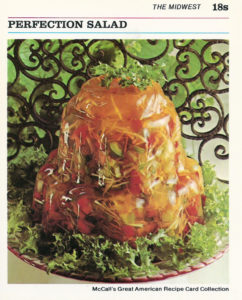 cabbage make the dish suitable for a classic first course, but the apple flavored gelatin casing (if you can do it with eggs, why not roughage) is that bit of sweetness you look for after the main course…Perfection.
cabbage make the dish suitable for a classic first course, but the apple flavored gelatin casing (if you can do it with eggs, why not roughage) is that bit of sweetness you look for after the main course…Perfection.
Ingredients:
2 envelopes unflavored gelatin
1/2 cup sugar
1 teaspoon salt
1 can (12 oz) apple juice
1/2 cup lemon juice
2 tablespoons vinegar
1 cup shredded carrot
1 cup sliced celery
1 cup finely shredded cabbage
1/2 cup chopped green pepper
1 can (4 oz) chopped pimiento
Directions
- In small saucepan, combine gelatin, sugar, and salt; mix well.
- Add 1 cup water. Heat over low heat, stirring constantly, until sugar and gelatin are dissolved. Remove from heat.
- Stir in apple juice, lemon juice, vinegar, and 1/4 cup cold water. Pour into medium bowl. Refrigerate 1 hour, or until mixture is consistency of unbeaten egg white.
- Add carrot, celery, cabbage, green pepper, and pimiento; stir until well combined.
- Turn into decorative, 1 1/2-quart mold. Refrigerate 4 hours, or until firm.
- To unmold: Run small spatula around edge of mold; invert onto serving plate. Place hot dishcloth over mold; shake gently to release. Repeat, if necessary. Lift off mold. Refrigerate until ready to serve. Makes 8 servings.
HOT TUNA AND EGG BUNS
When preparing the family meal, often the question of whether the children will eat it or not must be faced. Kids can be real picky eaters.
“I don’t like vegetables!”
“Meatloaf is gross!”
“What stinks?!”
It can be a challenge to provide them a diverse diet without the dreaded complete and utter meltdown. But, thanks to McCall’s, a well polled, we’re sure, list of children’s favorites has been assembled – simple recipes that keep the kids coming back for more. The top-choice, albeit experimental, is Hot Tuna and Egg Buns. This recipe has all the stuff kids love to eat after a pick-up game of billiards: tuna salad, cheddar cheese, buttery rolls, and green olives…wait, green olives?
1 can (7 oz) solid-pack tuna, drained and flaked
4 stuffed green olives, sliced
4 oz small Cheddar cheese cubes
3 hard-cooked eggs, coarsely chopped
1/3 cup mayonnaise or cooked salad dressing
3 tablespoons sweet-pickle relish
2 tablespoons finely chopped onion
1/4 teaspoon salt
8 frankfurter rolls
Directions:
- Preheat oven to 400F.
- In medium bowl, combine tuna, olives, cheese, egg, mayonnaise, pickle relish, onion, and salt; mix well.
- Spoon into rolls. Wrap each in foil. Place on cookie sheet.
- Bake 10 minutes. Serve hot, right in foil. Serves 8.
MILK CHICKEN
The main course of the meal is a terrific time to experiment with flavor combinations and spices. It is the showpiece of the meal. It should wow and satiate. And, while chicken can be so pedestrian, we think we have discovered a dish with enough familiarity to satisfy the pickiest of eaters, but just enough flare to display culinary creativity. Milk Chicken is that dish, but it is the garnish that takes it to a new level. 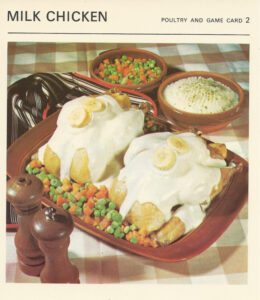 When I say, “Milk Chicken,” do you think bananas and hard-cooked eggs? Well, according to McCall’s, you should.
When I say, “Milk Chicken,” do you think bananas and hard-cooked eggs? Well, according to McCall’s, you should.
Ingredients:
2 small whole chickens, approximately 2 ½ lb.
2 stalks celery
2 1/2 cups water
seasoning
2 tablespoons flour
1 1/4 cups milk
2 tablespoons butter
1 egg yolk
Garnish:
1-2 hard-cooked eggs
1-2 bananas
cooked mixed vegetables
Directions:
- Put the whole chickens (or joint them if pan is not sufficiently large) into pan, add diced celery, water, and seasoning.
- Bring to boil; remove any scum from the top of the liquid, cover pan, lower heat, simmer gently – allow 45 minutes for jointed chicken, 1 hour for whole birds – until tender but unbroken; lift onto hot dish.
- Blend flour with half the milk, stir into stock, and cook until thickened.
- Add the butter and the egg blended with the remainder of the milk, and COOK GENTLY without boiling for several minutes.
- Strain some of the sauce over the birds, then garnish with the sliced hard-cooked egg, bananas, and vegetables.
PRUNE WHIP
A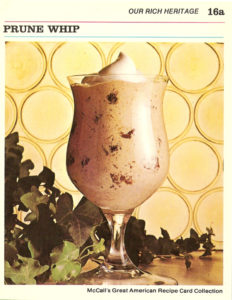 sweet treat is a familiar way to complete a meal. Some prefer the bitter-sweet decadence of chocolate; some prefer the salty-sweet appeal of caramel; others, the sun-kissed sweetness of fruit. Whatever the preference, dessert is a delight. We present Prune Whip and Custard…enough said!
sweet treat is a familiar way to complete a meal. Some prefer the bitter-sweet decadence of chocolate; some prefer the salty-sweet appeal of caramel; others, the sun-kissed sweetness of fruit. Whatever the preference, dessert is a delight. We present Prune Whip and Custard…enough said!
Ingredients:
1 pkg (12oz) pitted prunes
2 teaspoons lemon juice
2 egg whites
Dash salt
1/4 cup sugar
1/4 cup heavy cream, whipped
Custard Sauce (below)
Directions:
- Cook prunes as package label directs. Drain prunes, reserving liquid. Remove 1/2 cup cooked prunes for later.
2. Purée remaining prunes in blender or food mill with 1/2 cup of cooking liquid. Add lemon juice. Let cool.
3. With mixer at high speed, beat egg whites with salt until frothy. Gradually beat in sugar; beat until stiff peaks form.
4. Add purée of prunes, 1/4 cup at a time, beating well. Beat at high speed, 2 minutes.
5. Chop remaining prunes and fold into mixture along with 1/4 cup cream, whipped. Turn into 6 or 8 sherbert dishes.
6. Refrigerate. Garnish each with a little whipped cream, if desired, or serve with Custard Sauce.
Makes 6 to 8 servings.
Custard Sauce
Ingredients:
1 cup milk
2 egg yolks
3 tablespoons sugar
Dash salt
1/2 teaspoon vanilla extract
Directions:
- Heat milk in top of double boiler, over direct heat, until bubbles form around edge of pan.
- In small bowl, lightly beat egg yolks with sugar and salt. Gradually add hot milk, beating constantly. Return to double boiler. Cook over hot, not boiling, water until thin coating forms on metal spoon – 8 to 10 minutes. Stir in vanilla. Strain into small bowl. Refrigerate, covered, until well chilled.
HAM AND BANANAS HOLLANDAISE
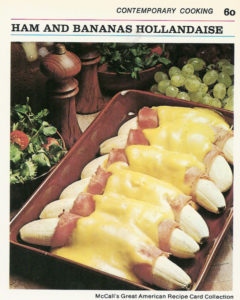 We know. We should have stopped at dessert. But we know how much you are enjoying yourself, and it is obvious you are going to want to stay for a late breakfast, and we have picked something truly special. Sometimes we get stuck in a culinary rut, cooking the same thing over and over again. So, let’s get off the boring track and see what kind of new culinary trends could be found in the contemporary cooking library. Hmm, Ham and Bananas Hollandaise, you say? That is some serious out-of-the-box culinary thinking. What’s that? A nice green salad to round out the meal? Sure, that makes sense. We can’t wait.
We know. We should have stopped at dessert. But we know how much you are enjoying yourself, and it is obvious you are going to want to stay for a late breakfast, and we have picked something truly special. Sometimes we get stuck in a culinary rut, cooking the same thing over and over again. So, let’s get off the boring track and see what kind of new culinary trends could be found in the contemporary cooking library. Hmm, Ham and Bananas Hollandaise, you say? That is some serious out-of-the-box culinary thinking. What’s that? A nice green salad to round out the meal? Sure, that makes sense. We can’t wait.
Ingredients:
6 medium bananas
1/4 cup lemon juice
6 thin slices boiled ham (about 1/2 lb)
3 tablespoons prepared mustard
2 envelopes (1 1/4-oz size) hollandaise sauce mix
1/4 cup light cream
Directions:
- Preheat oven to 400F. Lightly butter 2-quart, shallow baking dish.
- Peel bananas; sprinkle each with 1/2 tablespoon lemon juice, to prevent darkening.
- Spread ham slices with mustard. Wrap each banana in a slice of ham. Arrange in a single layer in the casserole dish. Bake 10 minutes.
- Meanwhile, make the hollandaise: In a small saucepan, combine sauce mix with 1 cup water, 1 tablespoon lemon juice, and cream. Heat, stirring, to boiling; pour over bananas. Bake 5 minutes longer, or until slightly golden. Nice with a green salad for brunch or lunch. Makes 6 servings.

